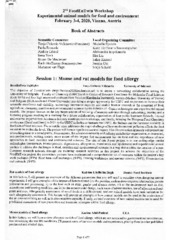Приказ основних података о документу
Higher degree of Maillard reaction induced by spray drying at high temperatures increases antioxidant activity of camel milk proteins
| dc.creator | Peruško, Marija | |
| dc.creator | Simović, Ana | |
| dc.creator | Stevanović, Nikola R. | |
| dc.creator | Radomirović, Mirjana Ž. | |
| dc.creator | Smiljanić, Katarina | |
| dc.creator | Stanić-Vučinić, Dragana | |
| dc.creator | Ghnimi, Sami | |
| dc.creator | Ćirković-Veličković, Tanja | |
| dc.date.accessioned | 2022-05-18T13:35:45Z | |
| dc.date.available | 2022-05-18T13:35:45Z | |
| dc.date.issued | 2020 | |
| dc.identifier.uri | http://cherry.chem.bg.ac.rs/handle/123456789/5130 | |
| dc.description.abstract | Objective. Camel milk is highly nutritious food with many health benefits proposed. Demand for camel milk has increased worldwide. Production of camel milk powders facilitate its transport, prolonge shelf-life, and also offer an attractive additive for various food products. In this study we examined the effect of freeze/spray drying treatment for camel milk powder production, on physiochemical and functional properties of camel milk proteins. Material and Methods. Whole camel milk powders were prepared by spray drying treatment at six different inlet temperatures (190°C - 250°C) or by freeze drying. The soluble protein fractions upon the treatments were analysed by combination of electrophoretic and spectroscopic techniques. Structural and functional properties of camel milk proteins such as Maillard reaction products formation, antioxidant activity and protein solubility were assessed. Results. SDS-PAGE revealed non-uniform increase in Mw of major protein bands, while native electrophoresis revealed non-uniform decrease in pI values with increased inlet temperature of spray drying. That indicated attachement of lactose moieties to NH2-group of proteins via non-enzymatic Maillard reaction. Spectrophotometric analysis showed formation of intermediate Maillard reaction products (increased absorbance at 294 nm) and no detectable late Maillard reaction products formation. Higher inlet temperatures (230°C - 250°C) resulted in higher protein carbonyls formation and lower content of free amino groups as a result of Maillard reaction. Far-UV circular dichroism spectra showed no differences in secondary structures between freeze and spray dried samples. Antioxidant activity and protein solubility were increased with increase in inlet temperature. Conclusions. Our results showed that spray drying treatment promotes non-enzymatic glycation of camel milk proteins and exert significant effects on the techno-functional properties of CM powder such as nutritional value and shelf life. Thus, optimization of spray drying parametars is essential for production of high quality camel milk powders. Acknowledgments: This work was supported by the Ministry of Education, Science and Technological Development of the Republic of Serbia, grant number 172024. The project leading to this application has received funding from the European Union's Horizon 2020 research and innovation programme under grant agreement No 810752. | sr |
| dc.language.iso | en | sr |
| dc.relation | info:eu-repo/grantAgreement/EC/H2020/810752/EU// | sr |
| dc.rights | openAccess | sr |
| dc.rights.uri | https://creativecommons.org/licenses/by/4.0/ | |
| dc.source | 2nd FoodEnTwin Workshop Experimental anlimal models for food and environment, February 3-4, 2020, Vienna, Austria | sr |
| dc.subject | camel milk | sr |
| dc.subject | Maillard reaction | sr |
| dc.subject | spray drying | sr |
| dc.title | Higher degree of Maillard reaction induced by spray drying at high temperatures increases antioxidant activity of camel milk proteins | sr |
| dc.type | conferenceObject | sr |
| dc.rights.license | BY | sr |
| dc.citation.spage | 6 | |
| dc.citation.epage | 7 | |
| dc.type.version | publishedVersion | sr |
| dc.identifier.fulltext | http://cherry.chem.bg.ac.rs/bitstream/id/29845/bitstream_29845.pdf | |
| dc.identifier.rcub | https://hdl.handle.net/21.15107/rcub_cherry_5130 |


